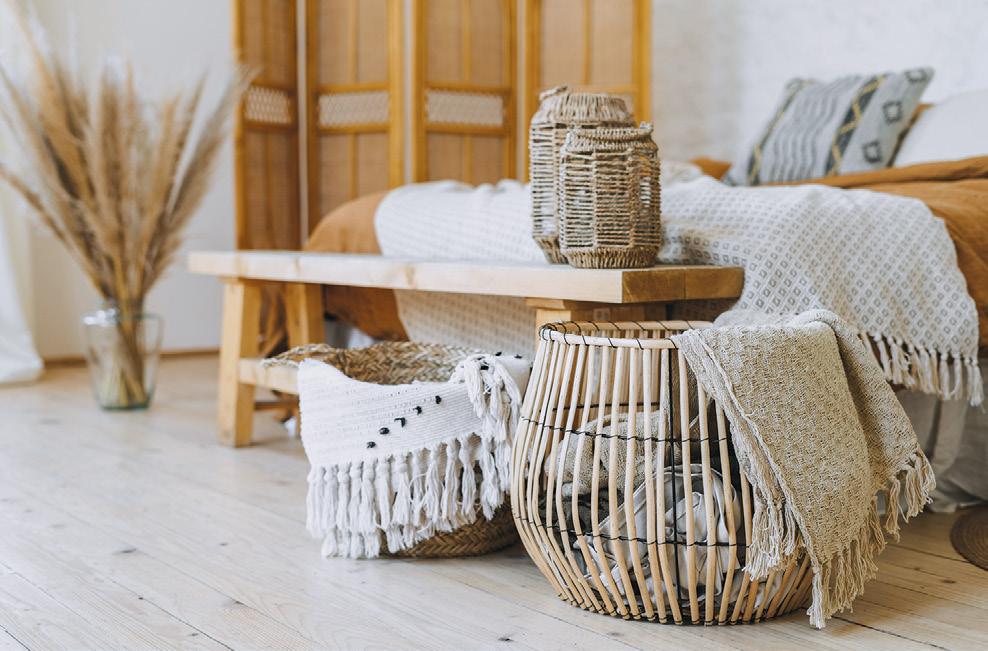
3 minute read
green living
Eco-Decor for the Home
How to Buy Sustainable Furnishings
Advertisement
by Sandra Yeyati
While comfort and beauty are clear priorities when shopping for furnishings, sustainability and health should be, too. By asking the right questions and doing a little up-front research, consumers have the power to appoint their sanctuaries with non-toxic, ecologically responsible items that are built to last and won’t pollute the environment.
According to the Sustainable Furnishings Council (SFC) (SustainableFurnishings.org), 80 percent of the environmental impact of any product comes from the materials used to make it, so it’s vital to ask about all of the material components in a piece of furniture.
Sustainably Harvested Wood
Because it is long-lasting and sturdy, wood can be an excellent, eco-friendly material. The most important consideration is that it hasn’t contributed to deforestation. SFC Executive Director Susan Inglis recommends third-party certification to confirm that wood was sustainably harvested in ways that preserve the forest’s ecosystem and benefit nearby communities. The Forest Stewardship Council (FSC.org) issues one of the industry’s most coveted independent certifications.
Reclaimed wood is another Earth-friendly option. “Perhaps the tree was cut down decades or centuries ago and made into a building, and now it’s being used to make a piece of furniture,” explains Inglis. A third sustainable choice is wood from a plantation that was established more than 25 years ago. “While it is not sustainable to convert natural forests to plantations today because you’re losing biodiversity, wood from long-established plantations is considered sustainable,” she says, adding that in those settings, new trees are planted to replace those harvested.
Non-Toxic Textiles
According to Inglis, the most environmentally sound textiles are made of natural fibers like organic cotton, linen, hemp and wool, which are long-lasting and can be recycled into new textiles. Synthetic fibers are petroleum-based and much less desirable.
Textile manufacturing practices can also be environmentally problematic. “Look for certification that they’re not polluting waters or using toxic dyes,” says
Aimee Robinson, owner of EcoBalanza, an organic furniture boutique in Seattle. She points to the Global Organic Textile Standard (Global-Standard.org) as a reliable organization which identifies producers of natural fibers that are organically grown without pesticides, while also considering the social and environmental impacts of their production systems.
Volatile Compounds and Unhealthy Chemicals
The SFC has identified five classes of chemicals commonly found in furniture that have been linked to cancer, endocrine disruption and immune impairment: volatile organic compounds like formaldehyde found in paints and finishes; flame retardants; fluoridated chemicals used in performance fabrics; antimicrobials; and polyvinyl chloride, known as PVC or vinyl. Inglis recommends that consumers ask about the potential presence of these chemicals when shopping for furniture and avoid them if possible.
Recycled Plastic
Recycling plastic to make furniture is trending, and that’s a plus, according to Inglis. “The best thing would be to avoid making anything out of plastic,” she says. “Plastic is a huge environmental problem, and our use of it continues to go up, especially in the COVID era. Only a small percentage of it is being recycled, leaving a lot of it to break down into microparticles, unfortunately. So, making things out of our plastic waste is good.”
Robinson, on the other hand, refuses to use any plastic in her handmade, all-natural furniture. “Plastics are a non-biodegradable, petrochemical product,” she says. “They’re polluting everything. The plastics industry is so insidious. Anything we can do on any front to pull away from petrochemicals in every aspect is good.”
Price and Durability
“Well-made furniture can get expensive, but you’ll have to replace cheap furniture because it’s not built to last. What’s cheap in the beginning is expensive in the end, because it’s not taking into account the cost of having to replace it or the cost of cleaning up an environment that gets more and more filled with junk,” says Robinson, who also recommends looking for well-made vintage pieces that can be restored and brought back to life.
“I recommend that you spend the most budget you have on a quality product, because that sofa, if it’s made well, can be reupholstered over and over again,” says Robin Wilson, a New York City designer and founder of Robin Wilson Home. “By keeping that sofa, you’re being eco-friendly to the world because it is not going into a landfill.”
Sandra Yeyati, J.D., is a professional writer and editor. Reach her at SandraYeyati@ gmail.com.

brizmaker/AdobeStock.com
GROW
YOUR BUSINESS
Secure this ad spot! Call us for special ad rates. 203-988-1808







